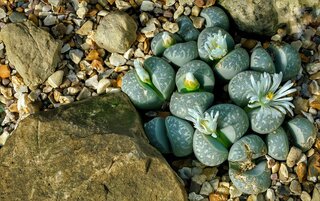After three years of waiting, your lithops finally bear flowers. As a first-time plant owner, you want to know how growers get seeds of these incredible succulents. To produce seeds, flowering plants such as lithops must undergo pollination.
How to pollinate lithops? Lithops pollinate through cross-pollination. To perform cross-pollination, transfer the pollen grains of one lithop to another lithop. You can do this with lithops of the same species because cross-pollination with another species doesn’t succeed.
Keep on reading because we will cover different topics related to lithops pollination.
How to Cross-pollinate Lithops
Lithops pollination involves easy steps, but first, prepare the following materials:
- Small paintbrush or plant-pollinator
- Two pots of lithops plant with flowers of the same species
Next, follow these steps in performing cross-pollination.
- Using the paintbrush, gently dab the tip of the brush to the anthers of the flowers. The yellow part at the center of the flower holds the pollen grains. Dab the brush three to five times to ensure the pollen grains stick to the tip of the paintbrush.
- Dab the tip of the brush to the anther of the second plant gently. By doing this, the pollen grains of the current flower transfer to the paintbrush’s end tip.
- Return to dab the brush to the first lithops flower. By doing this, you transfer the pollen of one lithop to the second lithop.
- Set aside your two lithops and wait for the seeds to develop and form.
Make sure to place the pollinated plants away from external factors that may disrupt the seeds’ development.
When Do Lithops Bloom?
You can expect your lithops to bear flowers in late November. Some species bloom between March and May or around summer from June to August. It takes three to five years before lithops bear flowers.
The flowers appear like a daisy with white petals and yellow at the center.
When it flowers, you will notice a small bud pushing its way out between the two leaves. Flowers open at 12 in the afternoon and last for a few hours. Before the sun sets, lithop flowers close.
Do Lithops Self-Pollinate?
Lithops don’t self-pollinate. Self-pollination happens when a flower places its pollen to its own anther, or of another flower in the same plant. In the case of lithops, you need to cross-pollinate two plants to have successful pollination. Insects cross-pollinate this plant in the wild.
Self-pollination doesn’t happen to some plants like lithops. The stigma of the lithops flower matures before the pollen does and sheds off. It means it needs pollen from another plant. This plant develops such a mechanism to avoid self-pollination.
What Happens to Lithops After Pollination
After they bloom and pollinate, lithops will stay dormant for a long time until they bear flowers again. New leaves will start to grow in the spring. Old leaves shrivel as young leaves begin to push themselves out of the center of the old ones.
Lithops undergo dormancy as an act of survival. With extreme heat and little to no rain in the wild during summer months, lithops rest to preserve their water content. This characteristic shows why they can last the summer without withering.
During the lithops’ dormancy period, watering them makes little sense. Leave them along during this season. Water will cause them to rot. However, if signs of withering become visible such as shriveling, moisten the soil. Don’t pour too much water as it will kill your lithops mercilessly.
When To Expect Seeds After Pollination
Seed development after pollination takes a while. It takes between eight to nine months for the seeds to develop into grown seeds. If your lithops grow flowers in March, you can expect seeds around November or December.
A capsule-like chamber wraps these seeds, and these capsule chambers make five to six compartments. In a single flower, you can harvest plenty of seeds. These chambers open when wet — hydrochastic. To get the seeds, you need to soak these chambers in water and scrape the seeds out.
In the wild, these capsules open when the rainwater wets them. When open, the raindrops scatter the seeds around. After two to 12 weeks, these seeds germinate and grow into another generation of lithops.
Related Questions
How Do You Breed Lithops?
The most common way of reproducing lithops is through seeds. You can also reproduce them by replanting their pups or division. However, lithops grow slowly, why people prefer growing them from seeds over divisions.
How Do You Get Lithops To Flower?
Take note that the shortest timespan before lithops flower take three years. After that, you can encourage them to bloom by adding fertilizer to their soil.
Do Lithops Die After Flowering?
Lithops don’t die after flowering. However, these succulents undergo a long period of dormancy. Lithops can live for up to 50 years.
Conclusion
To wrap it up, you can pollinate lithops using the cross-pollination process. You can do this by transferring pollen from one plant to another plant of the same species. Always remember that self-pollination won’t work on lithops.
Lithops bloom during early summer, some species bloom during winter or even late autumn. The flowers bloom in the early afternoon and close before dusk. You can expect seeds nine months after pollination. After bloom, lithops undergo a period of dormancy in the early summer months.
You can never go wrong with Lithops, the development of this succulent plant may be slow, but it’s all going to be worth it.

